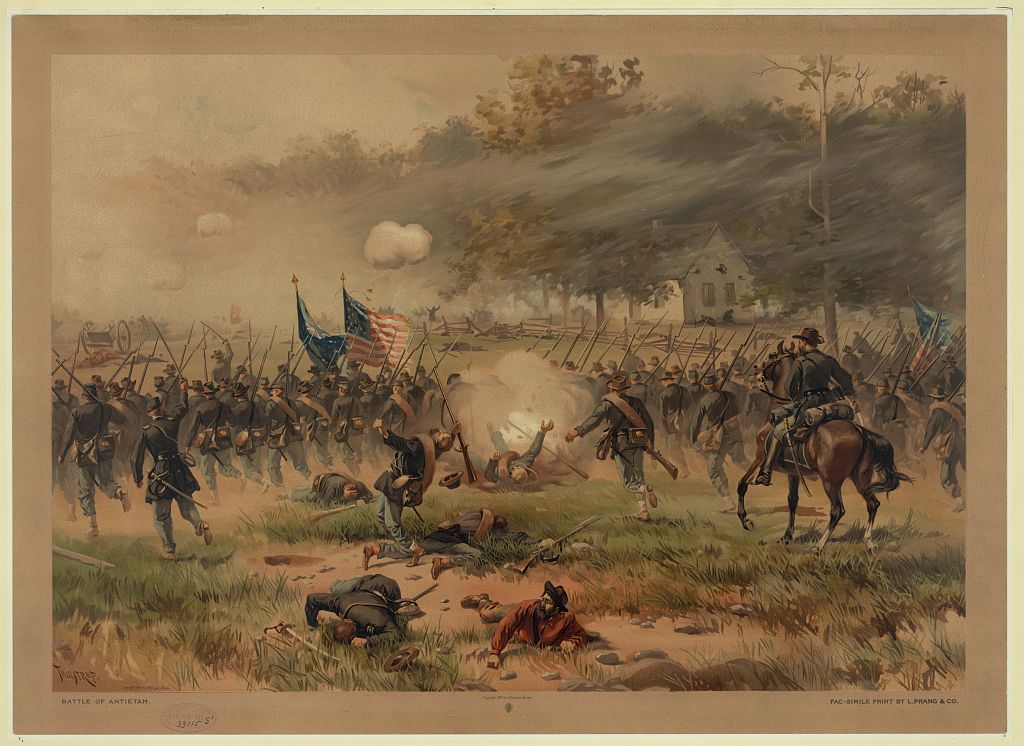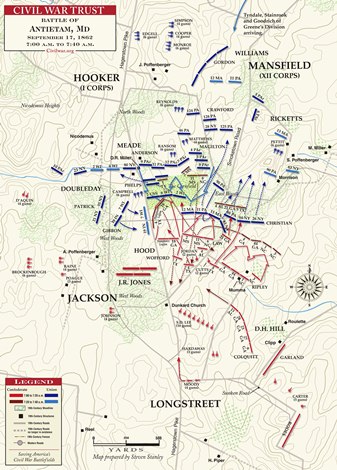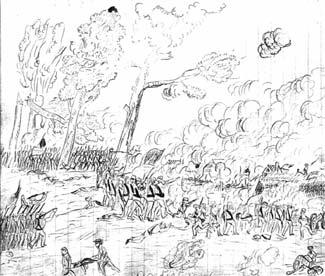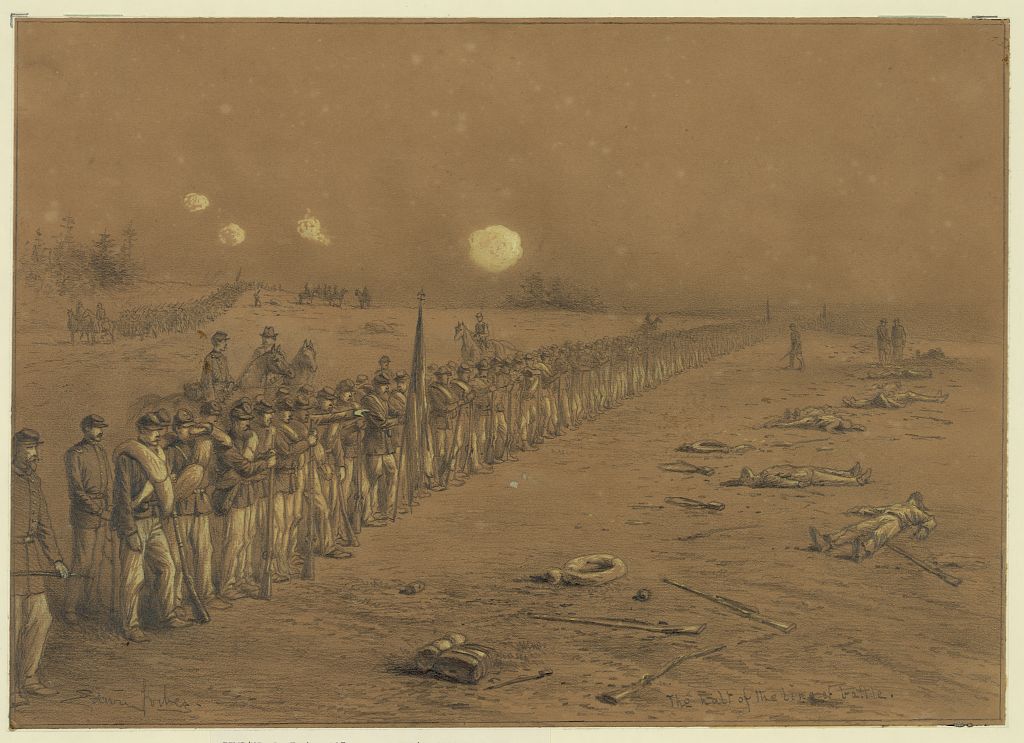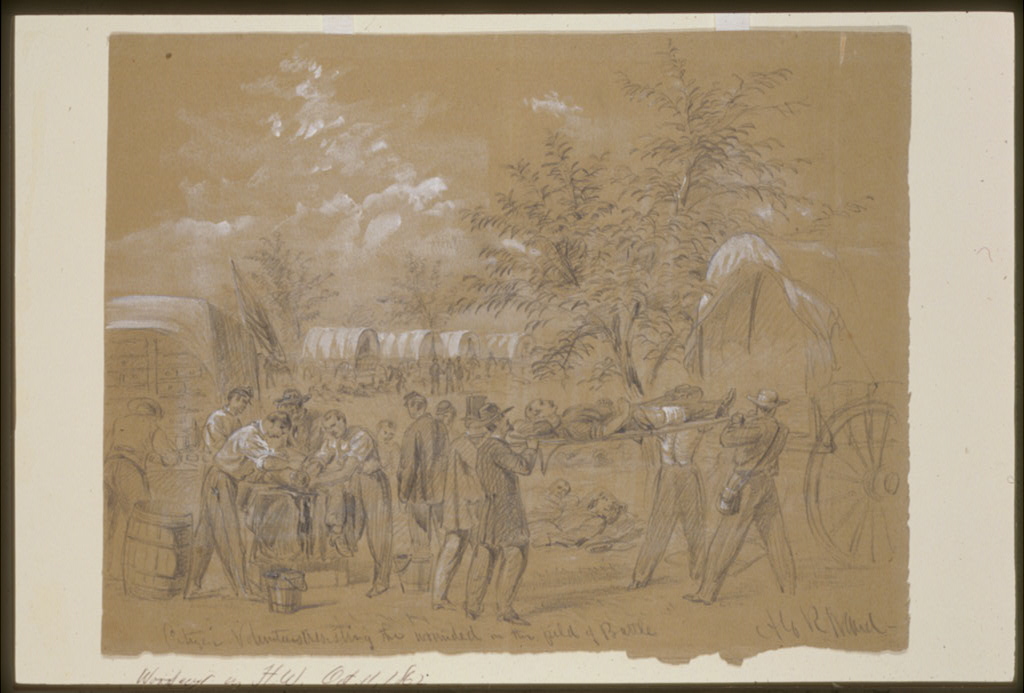Battle of Antietam / Sharpsburg, Maryland September 17, 1862
Army of the Potomac- Major General George B. McClellan
First Corps-Major General Joseph Hooker
Second Division- Brigadier General James B. Ricketts
Second Brigade- Colonel William H. Christian
26th New York Infantry Regiment - Lt. Colonel Richard H. Richardson
94th New York Infantry Regiment - Lt. Colonel Calvin Littlefield
88th Pennsylvania Infantry Regiment - Major George W. Gile
90th Pennsylvania Infantry Regiment - Colonel Peter Lyle
First Corps-Major General Joseph Hooker
Second Division- Brigadier General James B. Ricketts
Second Brigade- Colonel William H. Christian
26th New York Infantry Regiment - Lt. Colonel Richard H. Richardson
94th New York Infantry Regiment - Lt. Colonel Calvin Littlefield
88th Pennsylvania Infantry Regiment - Major George W. Gile
90th Pennsylvania Infantry Regiment - Colonel Peter Lyle
September 17, 1862—The Battle of Antietam commenced with an exchange of artillery fire at 3:00 a.m. The I Corps is on the Union right and launches the opening attack at first daylight. Hooker attacks southward with all three of his Divisions. Doubleday’s Division is on the right, straddling Hagerstown Pike.
Ricketts’ Division occupied the far left, and Meade’s Division is in the center slightly to the rear of Doubleday and Ricketts. The Union formations come almost immediately under the scrutiny of Confederate artillery crews.
The undulating countryside of continuous rolling crests and shallow valleys serves to compartmentalize the fight, and the soldiers often do not see units that are engaged directly to their front or flanks. While the terrain serves to mask the troops from direct rifle fire, time fused airbursts by Confederate artillery take a fearful toll on the densely packed troops.
At 6:00, Ricketts’ Division advances southward through the East Woods and by 6:20 Duryea’s First Brigade enters into the eastern portion of Miller’s Cornfield.
At 6:30 Christian’s Second Brigade enters the East Woods. As they emerge from the woods, they are subjected to converging Confederate artillery fire from S.D. Lee’s Battalion located at Dunker’s Church, and Stuart’s Horse Artillery positioned on Nicodemus Heights. The Second Brigade continues to advance down the Smoketown Road. Christian’s Second Brigade enters the battle just before 7:00 a.m. and shortly thereafter, Colonel Christian abandons his command and flees to the rear. Brigadier General Seymour, commanding the lead brigade of Meade’s Division temporarily attaches Christian’s Brigade to his own. The regiments of the Second Brigade are aligned from left to right 26th New York, 94th New York, 90th Pennsylvania, and anchoring the brigade’s right flank on the north side of Smoketown Road, is the 88th Pennsylvania. The 88th and 90th lead the formation, followed by the 26th and 94th New York. The Second Brigade continues down Smoketown Road and assaults Confederate defensive positions along the Mumma Farm Lane. The 88th fires a punishing volley into Confederates of the 21st Georgia (Trimble’s Brigade), and then joins the remainder of the Brigade in their attack on Mumma’s Lane.
Major Gile, commanding the 88th, is wounded in action and incapacitated. Captain Christian Carmack, of Company E, assumes command of the regiment, but is himself wounded shortly thereafter. Captain Henry Myers, of Company B, then assumes command of the regiment. When Company D of the 88th loses both their Company Commander and their First Lieutenant to wounds, Sergeant Charles Kartsher seizes the initiative and assumes command. He leads Company D throughout the battle. (Later commissioned for his bravery, First Lieutenant Kartsher will be killed in action at Fredericksburg.) Lieutenant
Petit of Company I, per army regulation, positions himself behind his Company and serves as a file closer. Seeing that the men were standing their ground and that the fight in front is a severe one, Petit sheaths his sword and picking up a rifle from a dead soldier, joins the fight alongside his troops.
The Confederate defenders manage hold the Second Brigade, but then retreat, setting the Mumma house afire as they depart. Seeking to exploit a gap between Ricketts’ right and Doubleday’s left, Hay’s Louisiana Brigade rushes northward to support the sagging Confederate line. In doing so, they expose their entire right flank to the Second Brigade. The 88th is in a perfect position and fires a devastating volley into Hay’s Confederates. It is not enough however, and while they had bloodied Hay’s Brigade, approaching them from the southwest is Hood’s entire Division. Hood’s Confederates fall heavily upon the Second Brigade, and the 90th Pennsylvania is particularly hard hit. The troops of the 88th hold their ground until their ammunition is exhausted. At approximately 8 a.m., Ricketts’ begins withdrawing his Division as fresh reinforcements from the Union XII Corps arrive and relieve the exhausted troops of Hooker’s I Corps. The remnants of I Corps withdraw and mass in positions to the north of the Poffenberger farm. Here they regroup and replenish. The 88th moves to support a neighboring artillery battery and while they still remain under indirect fire until the afternoon, for the soldiers of the Second Brigade, Ricketts’ Division, the fight is over.
The cost has been extreme. For the second and third time, the 88th loses its commanding officer while under fire. It will not be the last time. Of the soldiers detailed to the 88th Color Guard, all are wounded or killed. Color Corporal Lorenzo Wilson has his left leg, all but served by shrapnel, yet gamely proclaims of the dangling leg “Boys I’ve got it!”A surgeon would shortly remedy that. Company C loses all of its remaining officers to wounds. Sergeant Joseph Sergeant, of Company K, is wounded in the left breast. Sergeant Sergeant will be wounded again on May 12 1864, at the Battle of Spotsylvania, and will serve
throughout the entire war with the bullet from Antietam still embedded in his chest. One of Jackson’s Confederate veterans later remembers of the early morning fight in the cornfield, “We fought all day before breakfast, and went on picket all night before supper.”
Ricketts’ Division occupied the far left, and Meade’s Division is in the center slightly to the rear of Doubleday and Ricketts. The Union formations come almost immediately under the scrutiny of Confederate artillery crews.
The undulating countryside of continuous rolling crests and shallow valleys serves to compartmentalize the fight, and the soldiers often do not see units that are engaged directly to their front or flanks. While the terrain serves to mask the troops from direct rifle fire, time fused airbursts by Confederate artillery take a fearful toll on the densely packed troops.
At 6:00, Ricketts’ Division advances southward through the East Woods and by 6:20 Duryea’s First Brigade enters into the eastern portion of Miller’s Cornfield.
At 6:30 Christian’s Second Brigade enters the East Woods. As they emerge from the woods, they are subjected to converging Confederate artillery fire from S.D. Lee’s Battalion located at Dunker’s Church, and Stuart’s Horse Artillery positioned on Nicodemus Heights. The Second Brigade continues to advance down the Smoketown Road. Christian’s Second Brigade enters the battle just before 7:00 a.m. and shortly thereafter, Colonel Christian abandons his command and flees to the rear. Brigadier General Seymour, commanding the lead brigade of Meade’s Division temporarily attaches Christian’s Brigade to his own. The regiments of the Second Brigade are aligned from left to right 26th New York, 94th New York, 90th Pennsylvania, and anchoring the brigade’s right flank on the north side of Smoketown Road, is the 88th Pennsylvania. The 88th and 90th lead the formation, followed by the 26th and 94th New York. The Second Brigade continues down Smoketown Road and assaults Confederate defensive positions along the Mumma Farm Lane. The 88th fires a punishing volley into Confederates of the 21st Georgia (Trimble’s Brigade), and then joins the remainder of the Brigade in their attack on Mumma’s Lane.
Major Gile, commanding the 88th, is wounded in action and incapacitated. Captain Christian Carmack, of Company E, assumes command of the regiment, but is himself wounded shortly thereafter. Captain Henry Myers, of Company B, then assumes command of the regiment. When Company D of the 88th loses both their Company Commander and their First Lieutenant to wounds, Sergeant Charles Kartsher seizes the initiative and assumes command. He leads Company D throughout the battle. (Later commissioned for his bravery, First Lieutenant Kartsher will be killed in action at Fredericksburg.) Lieutenant
Petit of Company I, per army regulation, positions himself behind his Company and serves as a file closer. Seeing that the men were standing their ground and that the fight in front is a severe one, Petit sheaths his sword and picking up a rifle from a dead soldier, joins the fight alongside his troops.
The Confederate defenders manage hold the Second Brigade, but then retreat, setting the Mumma house afire as they depart. Seeking to exploit a gap between Ricketts’ right and Doubleday’s left, Hay’s Louisiana Brigade rushes northward to support the sagging Confederate line. In doing so, they expose their entire right flank to the Second Brigade. The 88th is in a perfect position and fires a devastating volley into Hay’s Confederates. It is not enough however, and while they had bloodied Hay’s Brigade, approaching them from the southwest is Hood’s entire Division. Hood’s Confederates fall heavily upon the Second Brigade, and the 90th Pennsylvania is particularly hard hit. The troops of the 88th hold their ground until their ammunition is exhausted. At approximately 8 a.m., Ricketts’ begins withdrawing his Division as fresh reinforcements from the Union XII Corps arrive and relieve the exhausted troops of Hooker’s I Corps. The remnants of I Corps withdraw and mass in positions to the north of the Poffenberger farm. Here they regroup and replenish. The 88th moves to support a neighboring artillery battery and while they still remain under indirect fire until the afternoon, for the soldiers of the Second Brigade, Ricketts’ Division, the fight is over.
The cost has been extreme. For the second and third time, the 88th loses its commanding officer while under fire. It will not be the last time. Of the soldiers detailed to the 88th Color Guard, all are wounded or killed. Color Corporal Lorenzo Wilson has his left leg, all but served by shrapnel, yet gamely proclaims of the dangling leg “Boys I’ve got it!”A surgeon would shortly remedy that. Company C loses all of its remaining officers to wounds. Sergeant Joseph Sergeant, of Company K, is wounded in the left breast. Sergeant Sergeant will be wounded again on May 12 1864, at the Battle of Spotsylvania, and will serve
throughout the entire war with the bullet from Antietam still embedded in his chest. One of Jackson’s Confederate veterans later remembers of the early morning fight in the cornfield, “We fought all day before breakfast, and went on picket all night before supper.”
Among the Eighty-Eighth soldiers killed or mortally wounded at Antietam/Sharpsburg are:
Company A: Corporal Jeremiah Boyer (MW), Privates John Hemminger (MW), Charles Millhoff
Company C: Corporals John Kellum (MW), Patrick Blaney (MW), Private James Downey
Company D: Private Samuel Caldwell (MW)
Company E: Corporal Benjamin Lee, Private William Boas Sr.
Company F: Privates R. Loudenslager, Benjamin Landell
Company H: Sergeant James Thompson (MW), Privates John Brittain, James Hennershitz
Company I: Privates Patrick Conlogue, James MacNichol, Jesse Tyson
Company A: Corporal Jeremiah Boyer (MW), Privates John Hemminger (MW), Charles Millhoff
Company C: Corporals John Kellum (MW), Patrick Blaney (MW), Private James Downey
Company D: Private Samuel Caldwell (MW)
Company E: Corporal Benjamin Lee, Private William Boas Sr.
Company F: Privates R. Loudenslager, Benjamin Landell
Company H: Sergeant James Thompson (MW), Privates John Brittain, James Hennershitz
Company I: Privates Patrick Conlogue, James MacNichol, Jesse Tyson
Out of 87,000 Union troops engaged 2,108 soldiers were killed, 9,540 soldiers were wounded, 753 missing & captured for a total of 12,401. The Eighty-Eighth suffers 16 killed, 58 wounded and as many as 37 missing or captured for a total of 111 out of 350 troops engaged.
Out of 45,000 Confederate troops engaged, 1,546 soldiers were killed, 7,752 soldiers were wounded, 1,018 missing & captured, for a total of 10,316.
The Battle of Antietam was a Union Victory
